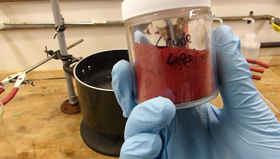Chromium trioxide
 Impure chromium trioxide
| |
| Names | |
|---|---|
| IUPAC name
Chromium trioxide
| |
| Other names
Chromic anhydride
Chromic acid anhydride Chromium(VI) oxide | |
| Identifiers | |
| Jmol-3D images | Image |
| |
| Properties | |
| CrO3 | |
| Molar mass | 99.99 g/mol |
| Appearance | Dark red solid |
| Odor | Odorless |
| Density | 2.7 g/cm3 (at 20 °C) |
| Melting point | 197 °C (387 °F; 470 K) |
| Boiling point | 250 °C (482 °F; 523 K) (decomposes) |
| 164.8 g/100 mL (0 °C) 169 g/100 mL (25 °C) 172.6 g/100 mL (40 °C) 198.1 g/100 mL (100 °C) | |
| Solubility | Soluble in acetic acid, acetone, diethyl ether, nitric acid, sulfuric acid |
| Vapor pressure | ~0 mmHg |
| Thermochemistry | |
| Std molar
entropy (S |
73.2 J/mol·K |
| Std enthalpy of
formation (ΔfH |
−589.3 kJ/mol |
| Hazards | |
| Safety data sheet | ScienceLab |
| Flash point | Non-flammable |
| Lethal dose or concentration (LD, LC): | |
| LD50 (Median dose)
|
80 mg/kg (rats, oral) |
| Related compounds | |
| Related compounds
|
Chromium(III) oxide |
| Except where otherwise noted, data are given for materials in their standard state (at 25 °C [77 °F], 100 kPa). | |
| Infobox references | |
Chromium trioxide is an inorganic compound with the formula CrO3. It is a dark red/crimson solid, widely used in synthesis and industry. It is the acidic anhydride of chromic acid.
Contents
Properties
Chemical
Chromium trioxide decomposes above 197 °C, yielding chromium(III) oxide and liberating oxygen:
- 4 CrO3 → 2 Cr2O3 + 3 O2
It is used in organic synthesis as an oxidant, often as a solution in acetic acid, or acetone in the case of the Jones oxidation. In these oxidations, the Cr(VI) converts primary alcohols to the corresponding carboxylic acids and secondary alcohols to ketones.[1] The reactions are shown below:
Primary alcohols to carboxylic acids:
- 4 CrO3 + 3 RCH2OH + 12 H+ → 3 RCOOH + 4 Cr3+ + 9 H2O
Secondary alcohols to ketones:
- 2 CrO3 + 3 R2CHOH + 6 H+ → 3 R2C=O + 2 Cr3+ + 6 H2O
Dry chromium trioxide reacts violently with ethanol and other organic compounds, causing them to combust on contact.
Physical
Chromium trioxide is a dard red/crimson solid in its anhydrous form, and red-orange in aqueous solution. It is very soluble in water and soluble in some organic solvents, such as acetone or diethyl ether, as well as sulfuric acid.
Availability
Chromium trioxide is sold by various chemical suppliers, though due to its hazards it's not easy to get hold of.
Preparation
Chromium trioxide can be prepared by reacting a Cr(VI) containing compound, such as sodium chromate or dichromate with concentrated sulfuric acid.
- H2SO4 + Na2CrO4 → CrO3 + Na2SO4 + H2O
- H2SO4 + Na2Cr2O7 → 2 CrO3 + Na2SO4 + H2O
The solid compound is filtered using a fritted funnel.
Projects
- Chrome plating
- Instantaneous ignition of alcohols
Handling
Safety
Chromium trioxide is a powerful oxidizer, highly toxic, corrosive, and carcinogenic. Avoid contact with alcohols.
Storage
Chromium trioxide should be kept in plastic or glass containers, with a proper label and a hazard symbol, in a dry place. If you're using glass, a good idea would be to keep the glass container inside a plastic container.
Since the compound ignites alcohols on contact, keep it away from any source of volatile solvents or products containing alcohols.
Disposal
A reducing agent, such as sodium metabisulfite, sodium sulfite or sodium thiosulfate can be used to turn CrO3 into the less toxic Cr(III) oxide. Glucose may also be used, albeit in a diluted solution. The neutralization must be done outside or in a fumehood, as the process will release Cr(VI) aerosoles, which are harmful and carcinogenic.
References
- ↑ Cotton, F. Albert; Wilkinson, Geoffrey; Murillo, Carlos A.; Bochmann, Manfred (1999), Advanced Inorganic Chemistry (6th ed.), New York: Wiley-Interscience
Relevant Sciencemadness threads
- Chemical pages without CAS Registry Number
- Articles without EBI source
- Chemical pages without ChemSpiderID
- Chemical pages without DrugBank identifier
- Articles without KEGG source
- Articles without InChI source
- Articles without UNII source
- Articles containing unverified chemical infoboxes
- Chemical compounds
- Inorganic compounds
- Chromium compounds
- Oxides
- Inorganic acid anhydrides
- Chromium oxides
- Oxidizing agents
- Carcinogenic